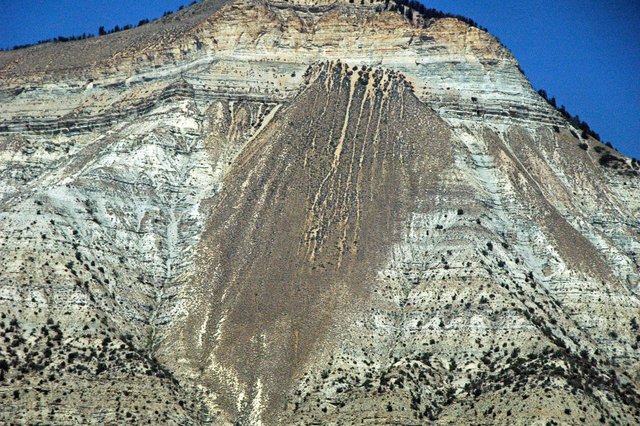
Image Source: Flickr - A Landslide on Mt. Logan, near Parachute, Colorado, USA
Hello, good people of the Steemit Community. I hope you are having some great time at your ends, and I do also hope I’d met you all well once again.
Today we shall be taking our time to look into a very interesting topic from the view points of a civil engineer. And even though a discussion from such ‘view point’ often appears to be quite a bit technical for the comprehension of a non-engineering person(s), yet I shall try as much as possible to make it not only comprehensible for all but also interesting to relate with.
The Field of Civil engineering, unlike every other engineering field, do not only take pride in being the mother of all engineering but also the field that does addresses the most basic necessity of human need.
Take for example, Water Resources Engineering, one of the major branches of Civil engineering. This branch of civil engineering is responsible for the improvement of the water supply techniques employed in your neighborhood and also improving the quality of that water by ensuring that the best and safest materials (like pipes and storage tanks) are employed in distributing this water to you.
This same branch also sees to the design and construction of water treatment facilities; the design and construction of sewage and waste water treatment facilities; the prevention of flood by the design and construction of flood control structures which include dams, weirs, canals and so forth; the protection of beaches and rivers, among others.
See how cogent and important this very particular branch seems? Well, this is only a grain out of what Civil Engineers are responsible for in your day to day activities. Well, let us look at another.
Say Transportation Engineering. In fact, our present global migratory tendencies are only possible due to the planning, designs and the exertions of the professionals in this field. How is this so?
Well, say the urban and community planners have decided just where and how the orientation of a particular town, village or city will be. They have decided just where, in a locality, will residential homes be situated, marketplaces be constructed, and have also allocated spaces for farms, hospitals and so on. And wait a minute, did I inform you that Urban and Community Planning is also another branch of Civil Engineering? Smiles
Well, say all these planning have been accomplished, and as it is quite important for humans to migrate themselves between these places. Then this is where Transportation engineering comes in. And no, they are not responsible for the design of cars and lorries. If you need some enlightenment in that arena, you might need to turn to folks like @mrbreeziewrites, @temitayo-pelumi, @aadempsea and the rest. I am sure they will put you through the rudiment of that exercise perfectly. But before you go, why don’t you finish up with this lesson first? winks
So, before that digression I was explaining how the transportation engineers come in here. These professionals are responsible for the designs and construction of the roads, highways, railroads and even the airports, and their various facilities for our efficient migration between these places.
Other major branches of civil engineering include: Construction Engineering, Environmental Engineering, Geotechnical Engineering and Structural Engineering. Even with mere seeing the names of these branches, you can imagine what role engineers play in your lives, I mean Civil Engineers.
Well today, however, our topic of discussion is pulled right from the very heart of the Geotechnical branch of Civil Engineering.
Let me digress here a bit in order to briefly explain what this branch (Geotechnical Engineering) entails. I just noticed I forgot to do just that in the previous paragraphs.
Yes. Geotechnical Engineering is that branch of civil engineering that is concerned about the behavior of soils (and even you will reckon that almost all branches of civil engineering deals with soil). The professionals of this fields study the behavior of the soil on the surface of the ground and beneath the surface. They determine the engineering properties, or let us just say the engineering relevance, of these soils. They do this prior to the construction of any civil engineering project including the construction of roads, bridges, buildings, tunnels, embankments, canals, and foundations.
Well, l can categorically say that this field is the most important field of all civil engineering fields and the least celebrated. I mean, no construction can ever be conducted without their green light. And in places where construction standards are pretty high, geotechnical engineers are called in at every turn of the construction. You cannot disregard their observation, else you are only constructing a death trap.
Alright, so where was I before that lovely digression? Okay, I wanted to introduce to us our discussion of the day, ‘Slope Stabilization and the Mass Wasting Phenomena’. Too much grammar, you say? Please don’t get discouraged because the fun has only just begun. Forget about the grammar and just follow me closely. I assure you that you won’t get lost - I promise.
Slope Stabilization and the Mass Wasting Phenomena
Often times we come across reports of landslides occurring in some part of the globe claiming the lives and properties of those around and fortunately sometimes neither lives nor properties are lost.
Numerous causes could have been the reason for the occurrence of this phenomenon but largely it is due to the instability or failure of the slopes over which these landslides occur.
So, how discussion is to enlighten us about what is meant by slope instability, causes of instability, how these instability can be averted, and how engineers analyze slopes in order to determine if they are stable or not.
So, what do we mean by Slope Stability?
In a more simply sentence, Slope Stability is the potential or likelihood of an earth (soil) covered slope to resist the movement of the soil on them. See the word ‘Slope’? Can I be confident that you are now familiar with what is meant by a slope?
Several factors could be responsible for triggering movements on these slopes but gravitational force is the main acting force responsible all factors that influence Instability of all slopes.
Mass Wasting is the term that refers to the actual downslope movement of soils or rocks observed on these slopes during either landslides (or creeps) usually under the influence of gravitational force.
The inclination of a slope, either gentle or steep, the magnitude of the frictional force present between the soil/rock materials, the strength of the soil material and their cohesive force are all factors that help maintain the stability of a slope. The collection of these factors is referred to as the slope’s shear strength as these are the forces resisting movement down the slope. The ability of these forces to resist the moment of the soil materials down a slope constitutes the ‘Stability’ of the slope.
For analysis purpose, geotechnical engineers do consider the angle of inclination of slopes to determine the behavior of that slopes under stress. But even you will reckon that this is not an extraordinary knowledge; that a slope will be more inclined to fail if its inclination is steep than if gentle. This is quite true. The steepest angle that a cohesionless slope can maintain without losing its stability is known as its angle of repose. Thus, even when a slope is made up of loose materials, its shear strength will perfectly compensate for the gravitational force acting on in if the slope possesses this angle of repose.
Causes of Slope Failure.
When a slope loses its stability for whatever reason, it is said to have failed. Slope failure could occur for whatever reason and in various ways. Let us take Landslide as a case study in order to fully understand this trick-ish concept.
If I am permitted to assume that we are all familiar with how landslides look when it is happening, then it will be very much easier for me to take a huge leap into its technicality. But if I am denied of such permission, then kindly avail yourself with the description by watching this youtube video clip I have found that seem to be able to provide you with the basics of how landslide looks (SEE VIDEO HERE). Or say, do you know how avalanche looks? Well then, there are high chances that you have an idea of what we are saying only that this time we are not talking about snow nor ice.
From our discussion so far, Landslides could only occur when a slope becomes unstable and when it is said to have failed. And the unstability/failure of a slope can arise only when any of the factors constituting the slope’s shear strength is altered. Such factors include the magnitude of the frictional force present between the soil/rock materials, the inclination or angle of repose of the slope, the strength and the cohesion of the soil material.
By the way, other causes of slope failure or instability include vibrations from blastings or machineries, earthquakes, volcanoes and, often times, construction activities.
However in any of the factors, water usually plays a very significant role which could be either detrimental or beneficial. Depending on the source of water, i.e either rainfall, snow or groundwater, and also depending on the amount, the overall presence of water in the soil increase the weight of the constituent soil on the slope.
This phenomenon is simply referred to as loading. And when the slope is overloaded, that is when the water becomes too much for the slope to withstand, it simple becomes unstable.
In fact, the presence of water could trigger number reactions even when the slope is not overloaded. Such reactions that can be caused by the presence of water include:
Absorption of water molecules by the mineral content: The mineral content of the soil may absorb the water. When this happens, apart from the increment in the overall weight of the soil, the frictional force of the soil will also be lost due to the presence of water acting as a lubricant between the mineral grains. Thus, the cohesion between the soil materials will be lost and the overall strength will reduce. This alteration results in the instability of the slope and thus the slope is very liable to failure resulting in landslide. Particularly, when the soil is clayey, adsorption of water tends to reduce the overall strength as dry clay are known to be stronger and binds together more than wet ones. Thus, increment of the moisture content of clay-rich soils is a disadvantage if such soils are present on a slope.
Dissolution of minerals: Some soils are rich in mineral cements (such as calcites, halite and gypsums). These cements bind the soil grains for form a single mass (body), thus responsible for the additional strength these soils mostly possess. Unfortunately, these cements are soluble in water. Water penetrating into these soils dissolves them, thus lessening the cohesive force between the soil grains. They become loosened and can quite fall under the weight of gravitational force. The top soils falling induce those immediately beneath them and those beneath trigger those beneath, as so on and so forth. This domino-like response is known as landslide.
Groundwater levels (that is, the level of water underground) changes: During wet seasons, the groundwater is bound to experience an increment in its level or height while otherwise is the case during the dry season. The pores of the soil then tend to absorb more water during the wet season than during the dry season. And by virtue of capillarity, the whole soil mass may likewise experience rise or fall of moisture content as the level of the groundwater also rises or falls. Once the point of saturation is reached, a slight tip in this delicate balance would trigger the occurrence of landslide. This singular cause could lead to the soil liquefaction which in turn leads to landslide.
The movement of the mass of material down the slope is simply referred to as Mass Wasting. Mass Wasting could be very fast or slow (taking place between seconds to decades of years) depending on the geographical and the topographical area of the place. It is majorly classified into two based on the duration in which it lapse.
Slides
This is also known as flows or falls. The movement of the material is rapid and of large mass down the slope of a hill or mountainside. Usually, they are triggered by presence of lubricant (usually water) between the soil grains. Sometimes the soil mass behave like fluid and sometimes they just cascade down the slope.
Creeps
These are usually long term movement of soil down the slope. It is also an usually slow movement. The cause are same as landslides only that this time, the soil has harder time getting saturated to trigger a slide or flow. However, its moisture content do increases to trigger a slight movement in the soil which accumulate over a long period of time to make evident the occurrence of creep.
Analyzing Slope Stability
Okay. So, if you are not intrigued yet up to this very stage, I am sorry to inform you that I cannot hold you further. This part of the write up is a bit more technical that various parts. So, I’ll advise you to either grudgingly read on and pretend to understand anyway, or you just jump to the conclusive part of this discussion which is the prevention and improving techniques on slope stability.
Civil Engineers have to analyze the stability of a slope in order to design for it and also to determine the risk that will be incurred in case of failure. During the analysis, the engineer would assume that the slope is made up of a solid rigid base over which a mass of soil sits. It is further assumed that the interaction between these two is through friction; that is it is the frictional force existing between the layer of the soil mass and the rigid base is the force responsible for the existence of the slope. Thus, the analysis tend to discern the circumstances that can cause the soil mass to slip off the base leading to slope failure.
As it is with all mathematical problems, there are usually more than one ways to solve a problem. The analysis of slope stability is no exception as there are several techniques that can be employed in order to reach a conclusion as to if a slope is safe for further utilization or if there is need to modify it for a specific purpose.
The first and the most common approach is the Limit Equilibrium Analysis.
Liquid Equilibrium Analysis (LEA)
With the assumption that the soil mass is always attempting to move downslide over the rigid body underlying a slope under the influence of gravity, this method attempts to identify the potential failure mechanisms and help develop factors of safety that help engineers discern if the slope is at equilibrium and how much alteration can be made while still maintaining the equilibrium.
The factor of safety is the ratio of the shear strength and the shear stress
Shear stress consists of all external factors tending to cause the slip of the soil mass down the slope. They include loading (overloading), lateral pressure, and transient forces. It is just logical to note that the shear strength must always be greater than the shear stress. In other words, the resistance (shear strength) of the soil mass to slip over the rigid base must always be greater than the external force trying to cause this slip. The ratio of any numeral values that would represent each of this expected to be greater than 1 if equilibrium is to be expected else a value lesser than 1 indicates that the shear stress is greater than the shear strength, thus slope failure is expected.
Numerically, a theory known as Terzaghi’s theory of shear strength is commonly employed for the limit equilibrium methods though variations are usually introduced, as you shall come to see later.
The theory (Terzaghi’s theory of shear strength) states that
τ = σ' tan(φ') + c'
Where σ' = (σ - u), is defined as the effective stress. σ is the total stress applied normal to the shear plane, and u is the pore water pressure acting on the same plane.
φ' = the effective stress friction angle, or the 'angle of internal friction'
tan (φ') = The coefficient of friction μ
c' = is called cohesion
Okay, I was pulling your legs there. Hahahaha
Terzaghi’s theory of shear strength actually states that all quantifiable changes in stress to a soil [compression, deformation, shear resistance] are a direct result of a change in effective stress, the coefficient of friction and cohesion between the soil grains. There you are.
Prevention of Unstability and Improving on the Stability of Slopes
1. Soil Stabilization
The most useful techniques usually employed by engineers around the globe to improve on stability and to also prevent one when the analysis of such slopes prove such slope to be potentially unstable is Soil Stabilization.
Now, here is a complete topic on its own; soil stabilization. It is complete and so in depth that I dare not venture into its discussion today, however I shall endeavor to briefly mention is basics.
Soil stabilization of the slope can be achieved by simply applying, by spraying, cementitious materials on the soil covering the slope. This will solidify the surface of the soil, up to a definite layer, thus preventing the infiltration of moisture into or on to the surface of the soil.
2. Slope’s Gradient Reduction and Drainage Pipes
The gradient of a slope define how steep or gentle the slope is. A steep slope can be reduced by have it graded to reduce its overall weight. Alternatively, drainage pipes may be inserted in the slopes to allow water to drain out of the slope easily. Water retained in slopes by whatever means tends to add to the overall weight of the slope thus draining the water away reduces the weight and makes the slope more stable.
3. Retaining Walls and Other Structures
Retaining walls can be constructed at the foot of a slope to help stabilize the slope or rather retain the soil if they eventually slide down the slope.
Piles, that is vertical column-like (or pillars) structures, can be provided in some selected sections of the slope to as like a kind of wind breaker in case of downslide occasion.

What is soil liquefaction? Causes, effects and measures - Geograohy and You
Slope Stabilization Systems - Terrafix Geosynthetics
What is Slope Stability? - Norwich University Online
An Overview on Methods for Slope Stability Analysis - jert
THE STABILITY OF SLOPES - University of Melbourne Online
Mass Wasting – Wikipedia
Slope Stability - Tulane
Slope stability analysis – GeoStru
What is Slope Stability? - Norwich University Online
Factors That Control Slope Stability - BC Open Textbooks

If you write STEM (Science, Technology, Engineering, and Mathematics) related posts, consider joining #steemSTEM on steemit chat or discord here. If you are from Nigeria, you may want to include the #stemng tag in your post. You can visit this blog by @stemng for more details.



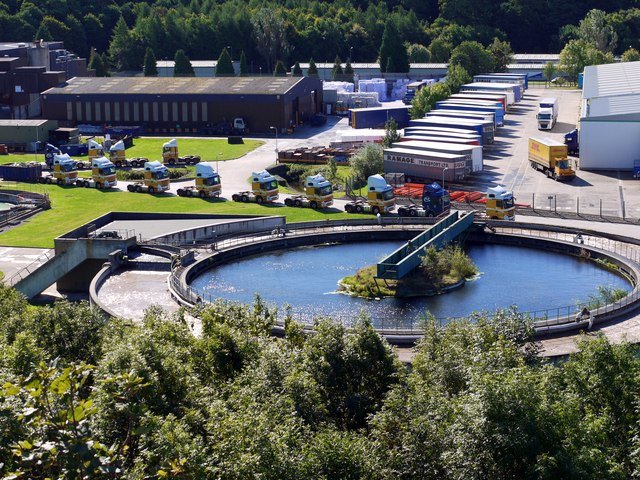
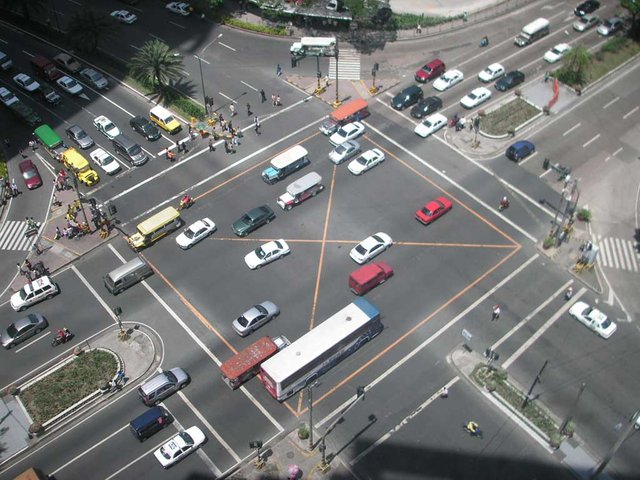
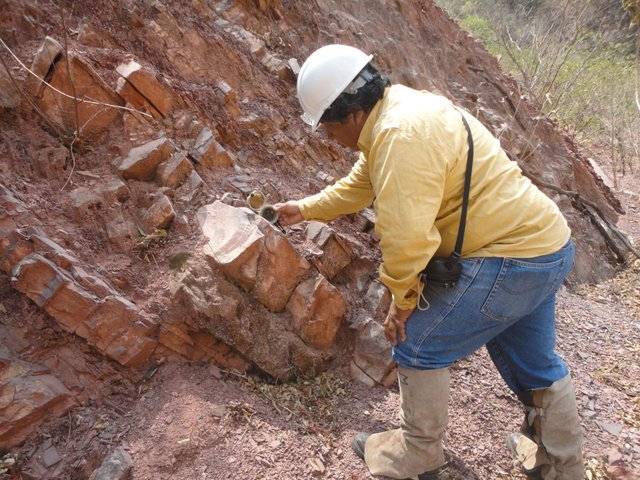
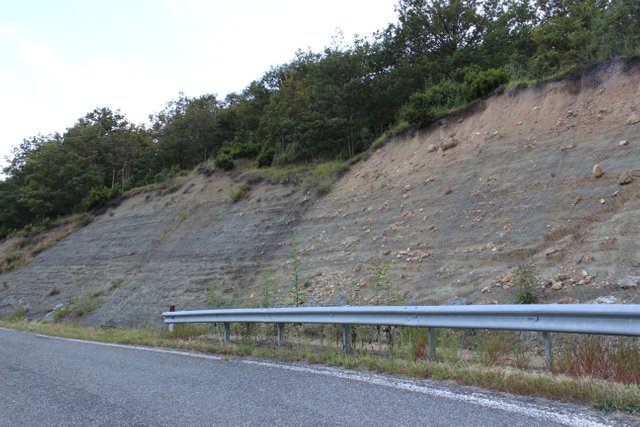

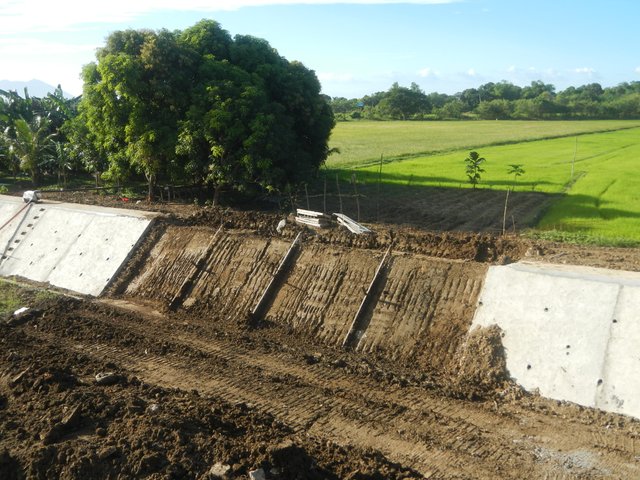
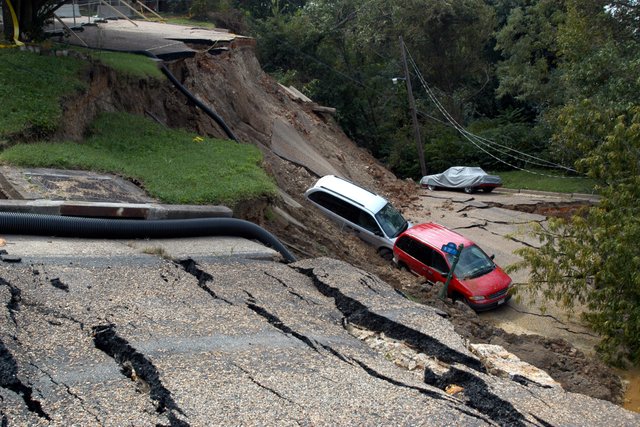
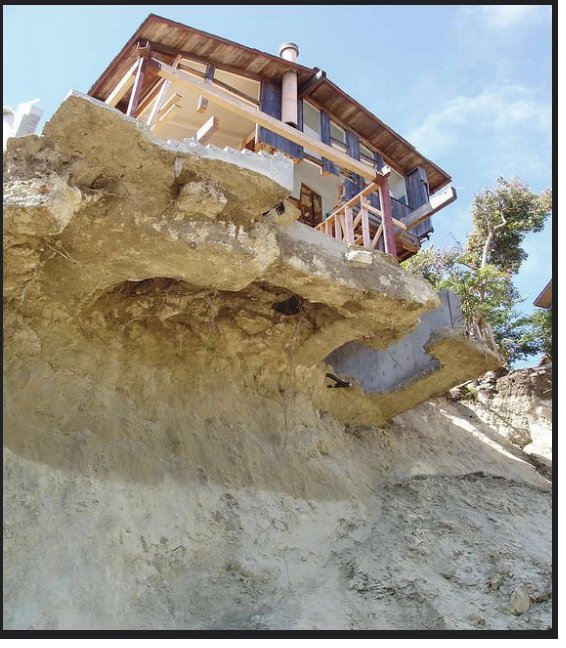
So much background work done here sir, great post.
By the way, I was wondering what the effect of erosion could be on the phenomenon in question.
Downvoting a post can decrease pending rewards and make it less visible. Common reasons:
Submit
Thanks very much, @temitayo-pelumi, for the kind words and for stopping by too. I do appreciate.
Well, as expected erosion is not favorable to slope. Usually, they wash away the foot of the slopes by either saturating the soil thus making them liable to being wash further, or simply pushing the soil outrightly away from the slope's foot by its force. Either event render the slope unstable and by virtue of gravitational force, soils immediate above the washed soil settles to replace them and these are washed too. This condition instantaneously triggers futher soil sliding down in order to balance the slope; landslide results.
Often times, to prevent this walls called retaining walls are built just at the foot of slides to ensure that such does not occur...
Downvoting a post can decrease pending rewards and make it less visible. Common reasons:
Submit
I have written about it before and I know exactly what you are talking about. Very good information you put up here in the hopes that someone will actually learn and listen to the cues before tragedies happen! Well done!
Downvoting a post can decrease pending rewards and make it less visible. Common reasons:
Submit
Hey @abumaryam
Here's a tip for your valuable feedback! @Utopian-io loves and incentivises informative comments.
Contributing on Utopian
Learn how to contribute on our website.
Want to chat? Join us on Discord https://discord.gg/h52nFrV.
Vote for Utopian Witness!
Downvoting a post can decrease pending rewards and make it less visible. Common reasons:
Submit
Very well.
We actually have a tragedy waiting to happen in Romania, where a highway is built right in the path of a huge possible landslide.
Civil engineers and civil engineering organizations warned to the imminence of the problem but nobody took any action:
http://www.contributors.ro/analize/tragedia-aciliu-%E2%80%93-mai-este-doar-un-pas/
It's in Romanian but you can at least see the pictures, if you don't want to use Google translate :D
Cheers and I liked your article!
Downvoting a post can decrease pending rewards and make it less visible. Common reasons:
Submit
Hello! I find your post valuable for the wafrica community! Thanks for the great post! We encourage and support quality contents and projects from the West African region.
Do you have a suggestion, concern or want to appear as a guest author on WAfrica, join our discord server and discuss with a member of our curation team.
Don't forget to join us every Sunday by 20:30GMT for our Sunday WAFRO party on our discord channel. Thank you.
Downvoting a post can decrease pending rewards and make it less visible. Common reasons:
Submit
Hmm🤔 didn't know there were so many disciplines under civil engineering... Well researched article👍, though i didn't complete it. I am more of an electronics person😀
Downvoting a post can decrease pending rewards and make it less visible. Common reasons:
Submit
Hahaha... Thanks for stopping by, Sir.
It is quite understandable that you dont get to read this finish. Even myself was tempted, at first, to make this a series. However, there we are. You can bookmark and take your time to read through sometimes later. I trust you may find it quite beneficial.
Downvoting a post can decrease pending rewards and make it less visible. Common reasons:
Submit
This post has been voted on by the steemstem curation team and voting trail.
There is more to SteemSTEM than just writing posts, check here for some more tips on being a community member. You can also join our discord here to get to know the rest of the community!
Downvoting a post can decrease pending rewards and make it less visible. Common reasons:
Submit
Well said sir
The things you wrote that cause it are just getting little improvement this recent day only the ignorance constructors are not interested in the future of their job. Thanks for sharing man you might have changed the orientation of a civil engineer or a construction personnel
Downvoting a post can decrease pending rewards and make it less visible. Common reasons:
Submit
Thank you very much, @osariemen. O appreciate your feedback and true, you have observed well. Many landslide accidents we witness, claiming lives and properties, are majorly due to neglect of civil engineers in those communities. And though they (landslides) are sometimes unpredictable, particularly those triggered from shockwaves or earthquakes, yet loss of lives could have been mitigated with thorough measures by the engineers.
Downvoting a post can decrease pending rewards and make it less visible. Common reasons:
Submit
I wish this was the case. I left a link on my comment about a similar situation in Romania. Crass incompetence is what defines the people here. I really hope that the next generation of civil engineers will be better at this!
Cheers!
Downvoting a post can decrease pending rewards and make it less visible. Common reasons:
Submit
that is very great, bringing this kind of situation to the fore, something we all neglect @ abumaryam thanks for this.
resteem this you are indirectly contributing to a saver,clearner enviroment resteem upvote
Downvoting a post can decrease pending rewards and make it less visible. Common reasons:
Submit
Thank you very much for stopping by and for commenting. Thanks for the kind words too.
Downvoting a post can decrease pending rewards and make it less visible. Common reasons:
Submit
You are always welcome to join us and get more recognition for your posts. You can find more information about geopolis here or join our Discord server.
Downvoting a post can decrease pending rewards and make it less visible. Common reasons:
Submit